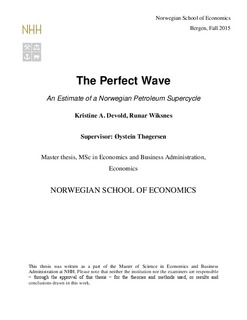The perfect wave: an estimate of a Norwegian petroleum supercycle
Master thesis
Permanent lenke
http://hdl.handle.net/11250/2383923Utgivelsesdato
2015Metadata
Vis full innførselSamlinger
- Master Thesis [4378]
Sammendrag
Over the last decades, the relationship between natural resource discoveries on macroeconomic
development has been thoroughly debated. The importance of maintaining a sustainable
development in mainland industries has made this a topic of interest for both economists and
regulators. This master thesis aims to examine and quantitatively assess how the Norwegian
economy has been affected by the evolution of its petroleum sector. We also relate our findings to
earlier contributions on this topic from both theoretical and empirical literature.
We examine the effect of the petroleum industry on the Norwegian economy by conducting two
comparative analyses. First, following a theoretical two-sector model, we compare the impact of
booms and busts in oil prices on macroeconomic variables in two resource economies, Norway
and Australia, and a non-resource economy, Sweden. Generally, we find that the predicted
dynamics can be identified in the resource economies, but that these responses have changed
through time. Notably, the introduction of a floating exchange rate has allowed the real effective
exchange rate to respond to oil price fluctuations, thus shielding the remaining economy. Other
institutional effects, such as the Norwegian fiscal rule, sovereign wealth fund and a well-defined
monetary framework might also have contributed to this effect.
Second, we build a counterfactual scenario in which Norway did not discover petroleum. This is
done by means of a synthetic control method, creating a synthetic Norway from 1972, using nonpetroleum
producing OECD countries. We find that Norwegian GDP per capita has been an
average of 15.6 % larger than what it would have been in the absence of petroleum resources.
Norwegian mainland industries have suffered an average loss in production of 12.4 % of
mainland GDP relative to the counterfactual scenario. We hypothesize that the latter is owed to
forfeited capital investment and real effective exchange rate effects. Furthermore, we find a
petroleum-driven supercycle in the Norwegian GDP per capita, peaking already in 1998,
suggesting that the contraction-phase is more mature than previously assumed. Although political
priorities in favour of the petroleum industry have been beneficial, the generated revenue streams
and returns on investment have crowded out parts of the mainland industries. This has
implications for adjustments in the coming years, when the petroleum industry is phased out. We
discuss briefly some scenarios for this adjustment process, and conclude.
